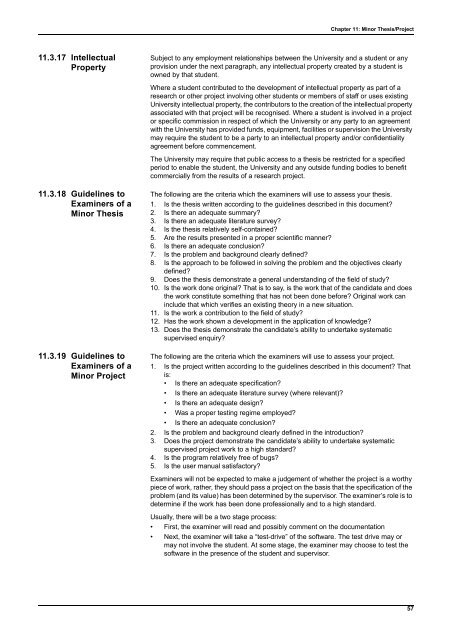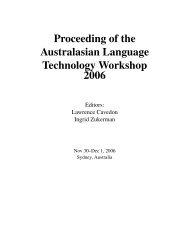The MBC information booklet - RMIT University
The MBC information booklet - RMIT University
The MBC information booklet - RMIT University
You also want an ePaper? Increase the reach of your titles
YUMPU automatically turns print PDFs into web optimized ePapers that Google loves.
11.3.17 Intellectual<br />
Property<br />
11.3.18 Guidelines to<br />
Examiners of a<br />
Minor <strong>The</strong>sis<br />
11.3.19 Guidelines to<br />
Examiners of a<br />
Minor Project<br />
Chapter 11: Minor <strong>The</strong>sis/Project<br />
Subject to any employment relationships between the <strong>University</strong> and a student or any<br />
provision under the next paragraph, any intellectual property created by a student is<br />
owned by that student.<br />
Where a student contributed to the development of intellectual property as part of a<br />
research or other project involving other students or members of staff or uses existing<br />
<strong>University</strong> intellectual property, the contributors to the creation of the intellectual property<br />
associated with that project will be recognised. Where a student is involved in a project<br />
or specific commission in respect of which the <strong>University</strong> or any party to an agreement<br />
with the <strong>University</strong> has provided funds, equipment, facilities or supervision the <strong>University</strong><br />
may require the student to be a party to an intellectual property and/or confidentiality<br />
agreement before commencement.<br />
<strong>The</strong> <strong>University</strong> may require that public access to a thesis be restricted for a specified<br />
period to enable the student, the <strong>University</strong> and any outside funding bodies to benefit<br />
commercially from the results of a research project.<br />
<strong>The</strong> following are the criteria which the examiners will use to assess your thesis.<br />
1. Is the thesis written according to the guidelines described in this document?<br />
2. Is there an adequate summary?<br />
3. Is there an adequate literature survey?<br />
4. Is the thesis relatively self-contained?<br />
5. Are the results presented in a proper scientific manner?<br />
6. Is there an adequate conclusion?<br />
7. Is the problem and background clearly defined?<br />
8. Is the approach to be followed in solving the problem and the objectives clearly<br />
defined?<br />
9. Does the thesis demonstrate a general understanding of the field of study?<br />
10. Is the work done original? That is to say, is the work that of the candidate and does<br />
the work constitute something that has not been done before? Original work can<br />
include that which verifies an existing theory in a new situation.<br />
11. Is the work a contribution to the field of study?<br />
12. Has the work shown a development in the application of knowledge?<br />
13. Does the thesis demonstrate the candidate’s ability to undertake systematic<br />
supervised enquiry?<br />
<strong>The</strong> following are the criteria which the examiners will use to assess your project.<br />
1. Is the project written according to the guidelines described in this document? That<br />
is:<br />
• Is there an adequate specification?<br />
• Is there an adequate literature survey (where relevant)?<br />
• Is there an adequate design?<br />
• Was a proper testing regime employed?<br />
• Is there an adequate conclusion?<br />
2. Is the problem and background clearly defined in the introduction?<br />
3. Does the project demonstrate the candidate’s ability to undertake systematic<br />
supervised project work to a high standard?<br />
4. Is the program relatively free of bugs?<br />
5. Is the user manual satisfactory?<br />
Examiners will not be expected to make a judgement of whether the project is a worthy<br />
piece of work, rather, they should pass a project on the basis that the specification of the<br />
problem (and its value) has been determined by the supervisor. <strong>The</strong> examiner’s role is to<br />
determine if the work has been done professionally and to a high standard.<br />
Usually, there will be a two stage process:<br />
• First, the examiner will read and possibly comment on the documentation<br />
• Next, the examiner will take a “test-drive” of the software. <strong>The</strong> test drive may or<br />
may not involve the student. At some stage, the examiner may choose to test the<br />
software in the presence of the student and supervisor.<br />
57
















